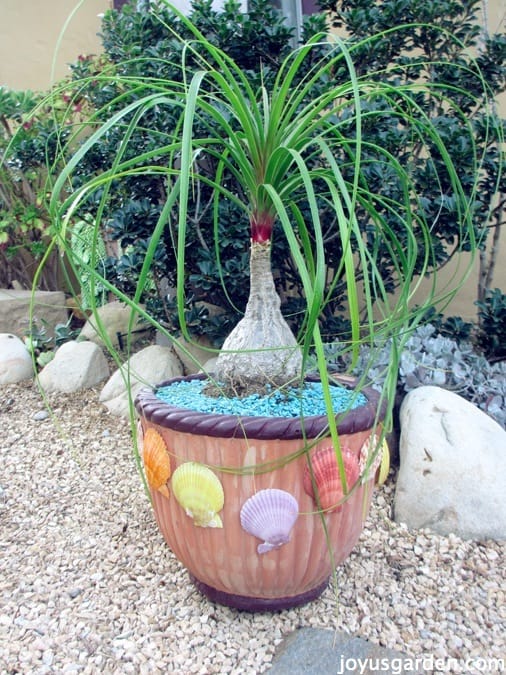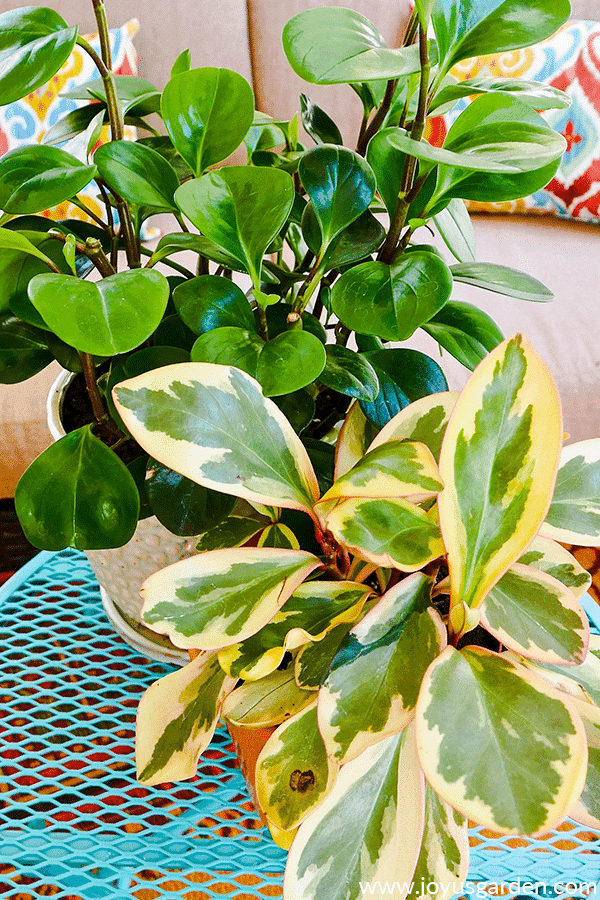Answering Your Questions About Snake Plants
We thought it would be fun and helpful to start a monthly series listing the top questions we get asked about specific plants. Keep reading to see the list we’ve compiled of the top inquiries and the succinct answers we provide. Here we’re answering the most commonly asked questions about Snake Plants.
Snake plants, which you may know as Sansevierias or Mother-in-Law’s Tongue, have become very popular due to the low maintenance they require. You’ve probably seen them for sale at local nurseries, big box stores, and online. Not only are they easy to find, but they are a great starter plant especially if you’re a beginning gardener.
We definitely recommend having one of these beauties in your home. Their popularity is likely one of the reasons Snake Plant care is one of our most popular blog posts.
You’ll find posts we’ve done on Snake Plant care, repotting, propagation, etc. at the end of each question where they apply. Here’s a round-up of most of our Snake Plant posts titled Snake Plant Care Guide.
Alright, let’s go over the 10 most frequently asked questions we get about caring for Snake Plants. Cassie and I will be answering the questions for you. You’ll see Brielle in the video. It’s a Joy Us garden collab!
Our Q & A series is a monthly installment where we answer your most common questions on caring for specific plants. Our previous posts cover Christmas Cactus, Poinsettia, Pothos, String Of Pearls, Lavender, Star Jasmine, Fertilizing & Feeding Roses, Aloe Vera, Bougainvillea, Snake Plants.
Questions About Snake Plants
1.) How often should I water my Snake Plant? Is Top Watering or Bottom Watering Best For Snake Plants?
It depends. I can’t give you an exact schedule because there are variables that come into play like pot size and type, soil composition, temperature and humidity of your home, and time of year. As a general rule, I water mine every 2 weeks in summer and every 3-4 weeks in winter.
I can tell you to go easy with the watering. It should be done when the soil is almost completely dry. If your Snake Plant is planted in fast-draining soil this will help it not to stay moist for too long.
I’ve never bottom watered my Snake Plants. Too much water building up in the bottom can lead to root rot. The only houseplants that I bottom water are my Phalaenopsis Orchids.
More details: Snake Plant Care
2.) What size pot do Snake Plants like? How crowded do Snake Plants really like to be?
Snake plants do best growing a bit tight and crowded in their pots. They won’t be happy in pots that are too big. The worse thing you can do is put your Snake Plant into too big of a pot because the soil has more of a chance to stay too wet. This is a sure-fire way to kill a Snake Plant.
It’s best to go up one size when repotting. For instance, if your plant is in a 4″ grow pot, the next size would be a 6″ pot. Don’t feel the need to rush when it comes to repotting – more on this towards the end.
3.) Where should I place a Snake Plant In My House? How much light does a Snake Plant Need?
One reason why Snake Plants are so loved is because of their adaptability. They’re tolerant of many light conditions with moderate or medium light, being the ideal. Like many houseplants, they grow best in bright natural light.
The varieties with darker leaves (like the popular Sansevieria trifasciata) and/or less variegation can tolerate lower light. Low light isn’t no light. Just know that Snake Plants in lower light will grow slower and the leaves could lose some of the variegation. Also, in lower light, water less often.
On the flip side, direct sun will cause the leaves to burn. Keep your Snake Plants out of hot, sunny windows. Finding a place in your home that offers moderate or medium-light is the way to go. In the darker winter months, you may have to move them to a brighter spot.
I commonly say it’s all about finding the right plant for the right light. If you have a variegated SnakePlant, it’s going to want brighter light to keep the variegation looking its best.
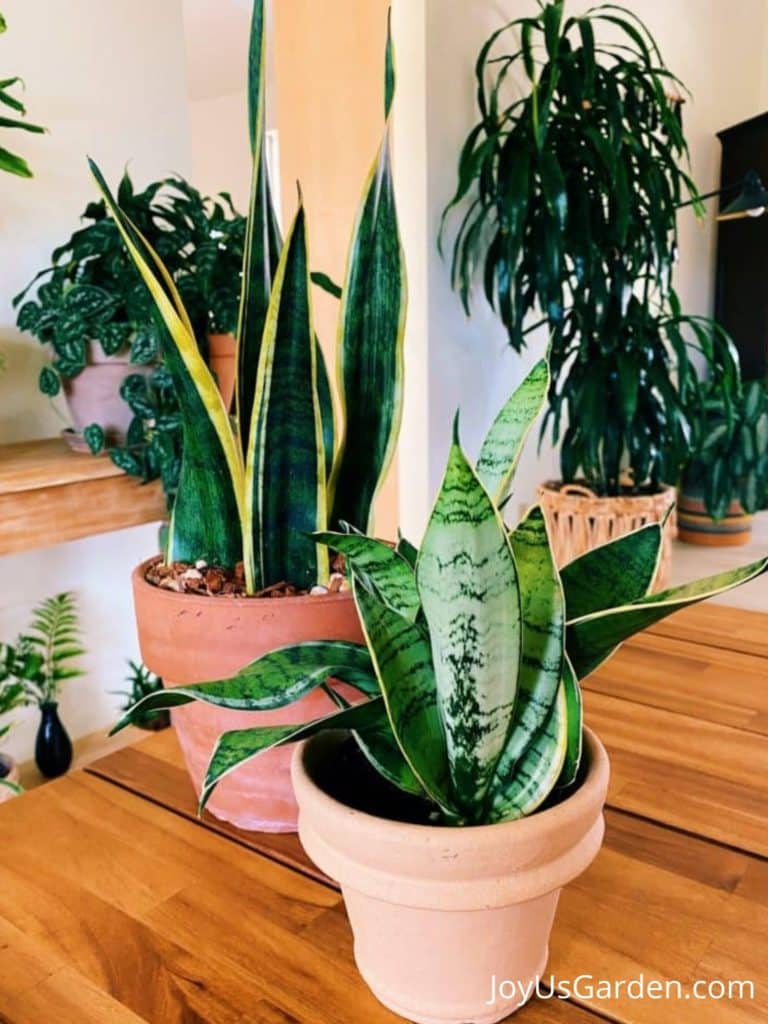
4.) Is a Snake Plant Indoor or Outdoor?
They can be both, depending on your climate zone. They are most commonly sold as indoor plants.
Cassie has always grown her Snake Plants indoors. She has very limited shade in her garden so they’d fry to a crisp in the hot Tucson sun.
I, however, have grown some outdoors. I have one growing outdoors year-round in Tucson on a shaded north-facing patio. I also grew them in the ground and in pots when I lived in Santa Barbara. The great thing for our readers who also live in temperate climates (growing zones 9b to 11) is that you have the ability to grow your Snake Plants outside in shaded spots.
If you put yours out for the summer months, keep it out of the direct sun. A helpful tip, if you’re in a climate with frequent summer rains, would be to place it in a protected area like a screened-in porch or covered patio.
5.) Does a Snake Plant need misting?
Neither Cassie nor I have ever misted our Snake Plants to increase humidity. They do fine without it. Saving the misting efforts for your Air Plants.
Cassie mists the leaves and wipes them clean once or twice a year. I put mine out in the summer rain for an annual shower and cleaning.
Remember, Snake Plants don’t want to be consistently moist. Misting can also cause the soil and leaves to stay too wet which can lead cause infection.
A reader asked why Sanke Plants get rust. Rust is a fungal disease that occurs when growing conditions are wet and warm.
I’ve never seen a Snake Plant with rust. I would think it would most occur from being kept too wet and/or misting on the regular.
6.) How do you propagate a Snake Plant?
There are a few methods. Because Snake plants are slow-growing, the fastest way is by dividing the plant.
Cassie has used the division method in the past to gift friends Snake Plants. It’s a fun way to get your hands dirty and see what’s going on with roots.
I recently did a post on propagating Snake Plants via leaf cuttings in soil. It’s always worked for me but it’s a much slower method. You can also propagate the cuttings in water.
By seed is another method but warning, it’s very slow!
More Details: Propagating A Snake Plant By Stem Cuttings, 3 Ways to Propagate A Snake Plant
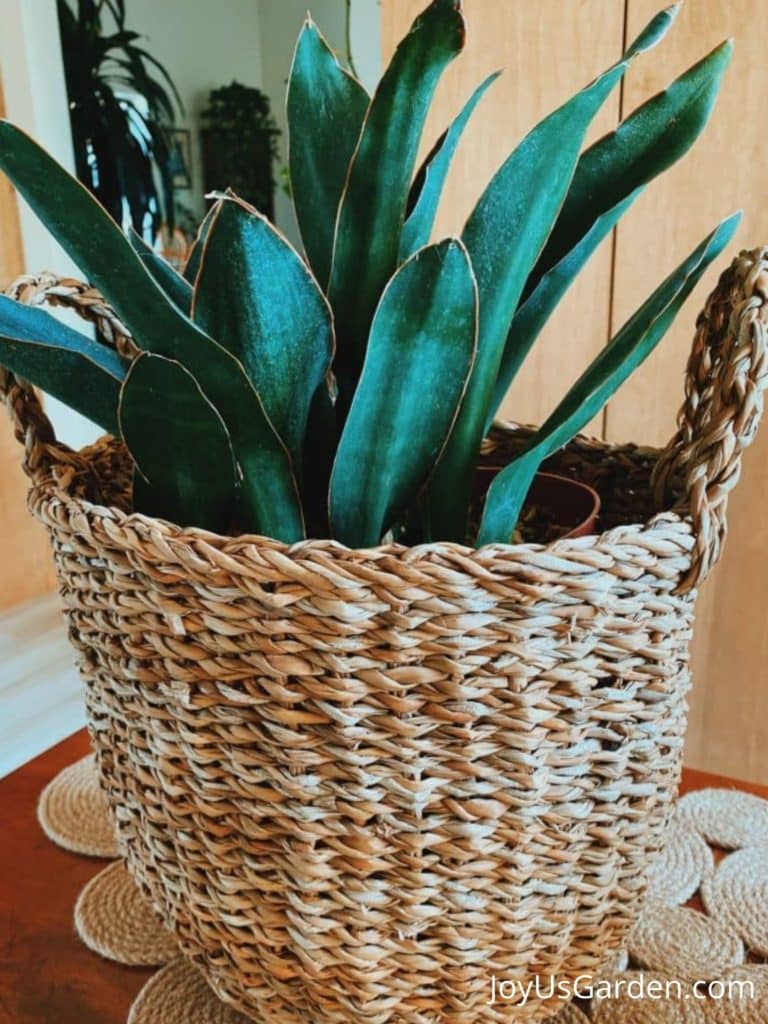
7.) How to make your Snake Plant bigger/grow faster?
We totally get it, you want a big Snake Plant like the beauties we all see on social media. However, there’s not really a specific tried and true method to speed the growth.
Snake Plants have a slow growth rate, especially indoors. The more light you give yours, the faster it’ll grow. If you have the ability to up the light factor without overdoing it, this would be your best bet.
Some varieties of Snake Plants will only grow to be 10″ tall, whereas other varieties can reach 5-6′ indoors.
Related: Snake Plant Leaves Falling Over
8.) When should you repot a Snake Plant?
Spring and summer are the best times to repot your plants. If you’re in a temperate climate, early fall is fine too.
Both Cassie and I have had our Snake Plants in the same pot for years. In general, every 4-6 years is fine. If the roots have broken the pot (this happens!), then it’s time.
If your Snake Plant is begging for a new pot and/or fresh soil, only go up one size. For instance, from a 6″ grow pot to an 8″ grow pot.
Don’t feel the pressure to repot every year or 2 because a Snake Plant doesn’t need it.
More Details: Snake Plant Repotting
9.) What is the best soil for Snake Plants? Can I use succulent & cactus mix for Snake Plants?
Your Snake Plant does best in a well-aerated and quick-draining soil mix to ensure it doesn’t stay too wet. I use a mixture of half succulent and cactus mix and 1/2 potting soil.
I’ve seen them growing in all succulent and cactus mix as well as in a mix with a lot of pebbles.
More Details: Snake Plant Repotting
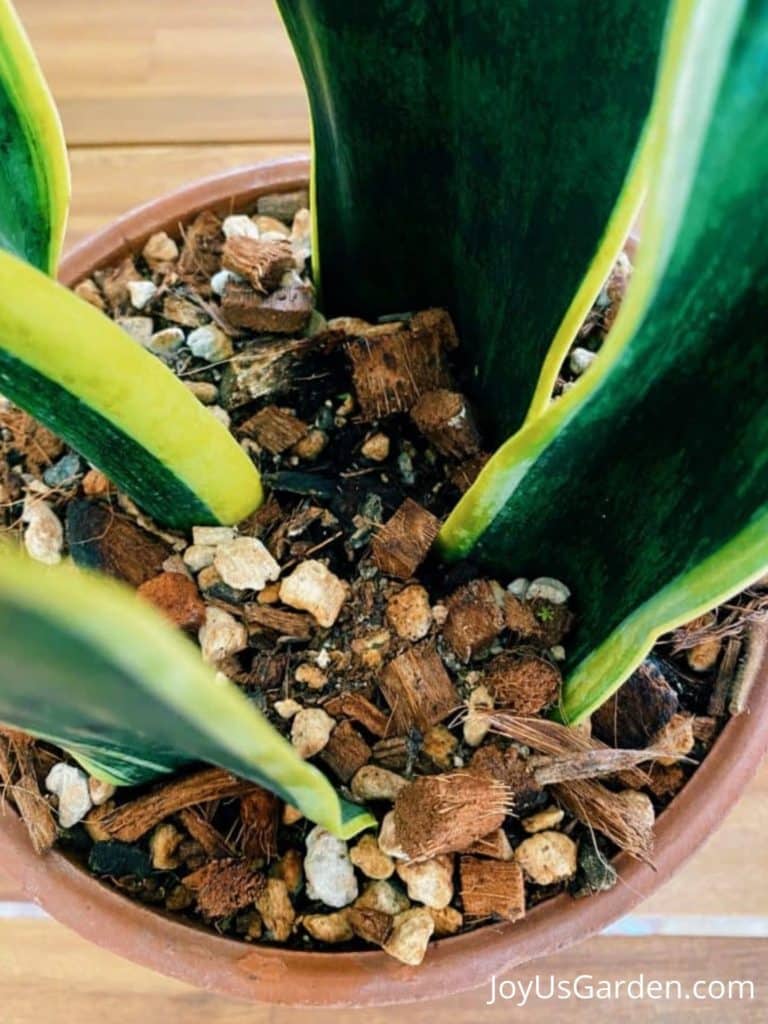
10.) Do Snake Plants flower?
Snake plants will rarely flower indoors. Cassie has never had any of her plants flower.
Mine growing outdoors in Santa Barbara sporadically flowered. The tiny white blooms on spikes are extremely fragrant and have a very sweet scent.
If you are specifically looking for an indoor flowering plant then a Snake Plant isn’t the way to go. Kalanchoes, Calandivas, Phalaenopsis, and Bromeliads are a much better purchase.
BONUS:
Why are they called Mother-In-Law’s Tongue?
The pointed tongue-shaped leaves and their sharp tips can symbolize the sharp tongue of a mother-in-law. With that being said, it’s totally up for individual interpretation!
Brief answers to these questions:
Some Of Our General Houseplant Guides For Your Reference:
- Guide To Watering Indoor Plants
- Beginner’s Guide To Repotting Plants
- Indoor Plant Care For Beginners
- 3 Ways To Successfully Fertilize Indoor Plants
- How to Clean Houseplants
- Winter Houseplant Care Guide
- Plant Humidity: How I Increase Humidity For Houseplants
- Buying Houseplants: 14 Tips For Indoor Gardening Newbies
- 11 Pet-Friendly Houseplants

If you want to buy some Snake Plants online, you can check out The Sill, Amazon, or Etsy.
We hope we were able to answer some of your questions about Snake Plants.
We’re making this answering commonly asked questions a monthly series. Be sure to come back next month because it’s all about Bougainvillea!
Check out our other Q & A installments: Bougainvillea, Aloe Vera, Fertilizing & Feeding Roses
Happy gardening,
Nell, Cassie, & Brielle
This post may contain affiliate links, you can read our policies here.
- About the Author
- Latest Posts
Nell, the founder of Joy Us garden, was born into a gardening family and grew up in Connecticut’s countryside. After living in Boston, New York, San Francisco, & Santa Barbara, she now calls the Arizona desert home. She studied horticulture & garden design, working in the field all her life. Nell is a gardener, designer, blogger, Youtube creator, & author. She’s been gardening for a very long time & wants to share what she’s learned with you.

